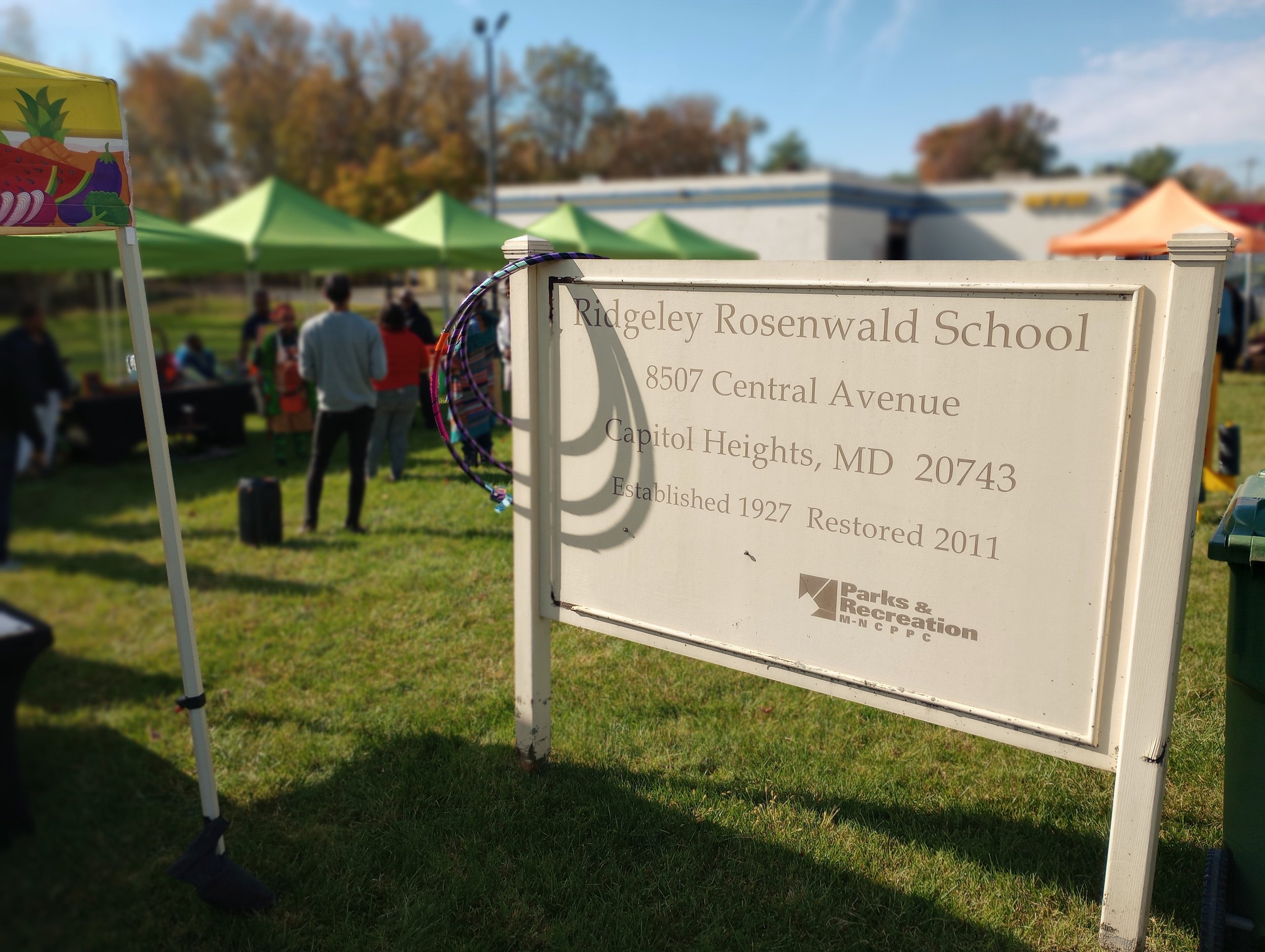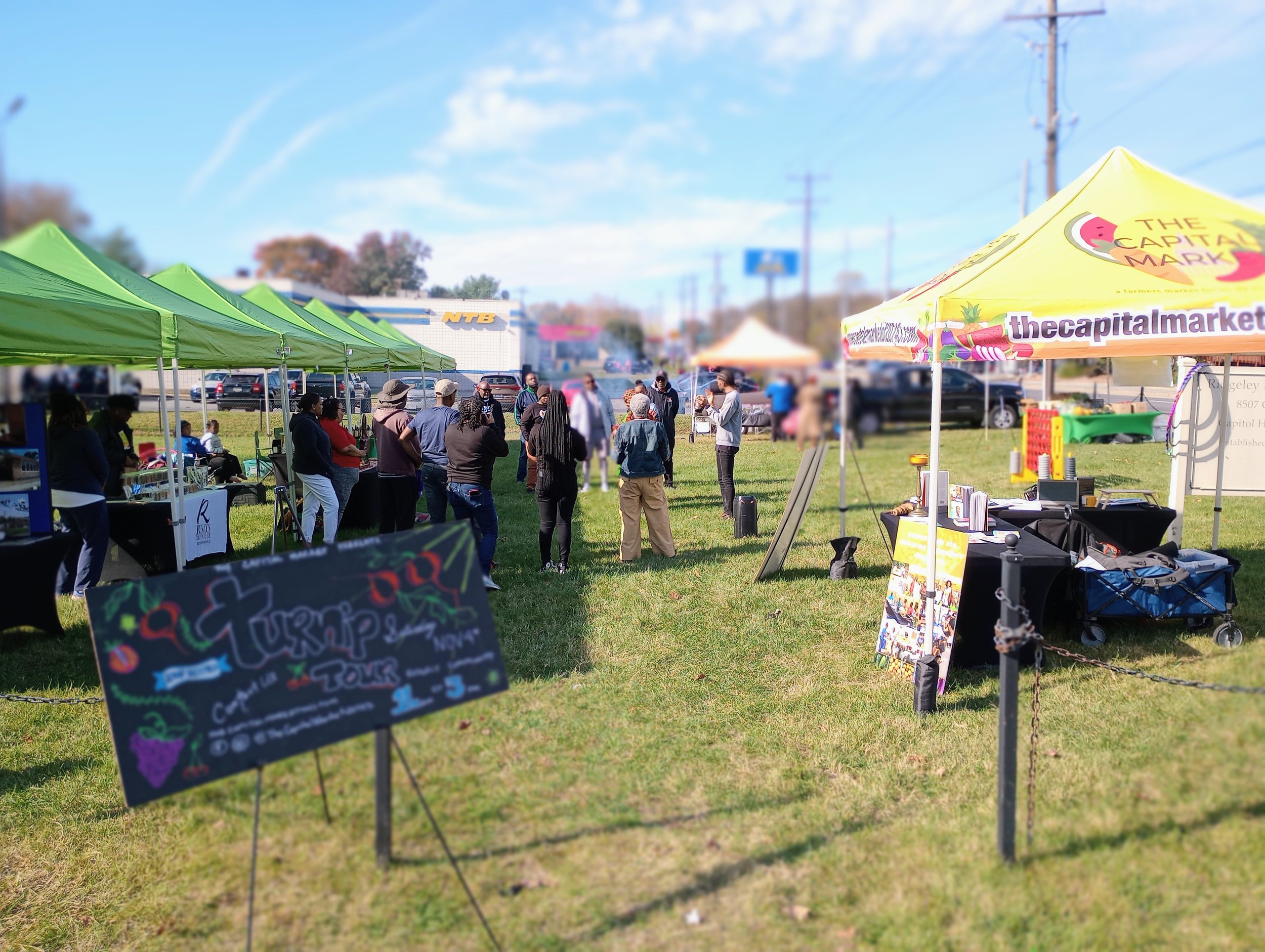Descendants of the Enslaved Unearth The Memory of their Ancestors Who Once Lived Along The Blue Line Corridor
Editor’s note: The Intersection refers to plantations, where Black people were enslaved, as “prison industrial camps.”
Along Central Avenue stands a beige sign that reads “Ridgeley Rosenwald School.” Near the sign, is a blacktop road that leads to the Rosenwald School Museum, once a functional all-Black neighborhood school. On Nov. 4, attendees for the Turnip Tour, a Capital Market pop-up farmers market, stood in a circle, not far from the beige sign, listening to Brittney Drakeford and La Verne Gray, descendants of enslaved Black people, speak about their connection to the land and their history of the place.
Attendees are there to commemorate Maryland’s Emancipation Day, which occurred on Nov. 1. During the Civil War, Maryland was a border state, which meant that the Emancipation Proclamation (which became law on January 1, 1863) didn’t immediately demand that white oppressors free Black people from the shackles of being property. More than a year later, on Nov. 1, 1864, the state finally freed enslaved Black people from chattel slavery. But some white families kidnapped Black children, re-enslaving under the guise of apprenticeships.
“What is remarkable is that freed people settled here along Central Avenue,” said La Verne Gray, a descendant of Lewis Ridgeley, who was enslaved on the Concord Plantation (prison industrial camp) in the 1800s.
Gray, whose ancestors donated land to build the community, said: “It is my privilege and honor to be able to let people know not just about the world of my family, but the world of the Black community that lives in this county.”
Artura Jackson is a sixth-generation Prince George’s County resident. She is also the site manager at the Ridgeley Rosenwald School museum, which is under the stewardship of the Maryland-National Capital Park and Planning Commission Prince George’s County Department of Parks and Recreation.Throughout the day, she led tours through the museum. For Jackson, this is a day to remind or to introduce people to the historical significance of the area along Central Avenue.
“Today is super special for me…,” she said. “I grew up less than a mile away from here. I did not know the history of this place. So to be able to activate this space; to be able to get people to come in, to bring their children to learn about history, is a historian's dream.”
Brittney Drakeford – one of many organizers for The Capital Market – said the point of the Turnip Tour was to travel to neighborhoods along the Blueline Corridor to share information about healthy foods; talk to community members about the implications of local redevelopment; and help community members remember and know the history of the land. The organizers stopped at five locations along the Blueline Corridor: The Sports And Learning Complex, Addison Road Metro Station, City of Seat Pleasant, Town of Capitol Heights, and Rigeley Community (Central Avenue). All these lands were once prison industrial-labor camps.
“The history of the Blue Line Corridor is…like many other places in the United States,” Drakeford said. “They are entangled with enslavement; land dispossession; development; and iterations of gentrification.”
For Drakeford, history is never something stuck in the past but is present with us now. She believes this should be considered when talking about community development. She wants developers to think about preserving history while building for the future.
“Often people talk about place-making,... [but] what we try to talk about at The Capital Market is place-keeping because these places are here, right?” she said.
The Capital Market organizers, a collective of family members, chose the Ridgeley community because of their connection to it. They’re descendants of Robert Harrod, Sr., who was enslaved at the Concord prison industrial camp. Gray's ancestor Lewis Ridgeley, was enslaved at the same place as Robert Harrod Sr., who when freed purchased 13 acres of land near modern-day Fedex field. She also knows the Ridgeley family. She attended church with some of them and once worked at the Rosenwald School museum.
“So we said, ‘What better place to celebrate Maryland's emancipation than on the land where our family was enslaved.’” she explained.
During the drink libation — an African tradition conducted by Cheryl McCloud, a native of Prince George’s County and a former Prince George’s County Public School educator, and after listening to Gray and Britrney speak, Susan Jackson said she was deeply moved by it.
Susan and Ralph Jackson, owners of Poetry in Bloom Apothecary, are Prince George’s County residents. Susan was inspired to become a Turnip Tour vendor after organizers informed her about the mission. However, they still weren’t familiar with the history of the land or the museum.
Ralph has traveled along Central Avenue hundreds of times, but never noticed the Rosenwald School’s beige sign. He thought, he said, that it was just “a regular ''area. He said if had been more informed about the place he would have had more reverence for it.
Now armed with the new knowledge and understanding of this place, coupled with a previous understanding of how Black people landscaped acres of land in the North and South, Susan was both inspired and proud.
“ We have created, invented, and reinvented [all kinds of things],” she said.
She continued: “Our ancestors built a whole community after being enslaved.”
Adriana Bradford, a chef, and poet, also wasn’t that familiar with the local history. She discovered the museum by accident. During the event, she had to take her daughter to the bathroom. The museum’s bathroom was the only rest area available to attendees. As she walked into the museum, she encountered some artifacts and the school’s history.
“As soon as you get to the door, you feel just the presence…of rich history; the presence of education; the presence of our people,” said Bradford, a first-generation Jamaican American.
The former school sits upon a layered history, as all U.S. land does. Originally, the Piscataway, and Nacotochatank (Anacostan) (indigenous people) lived on the land. After European colonization, due to violence, disease, and starvation, indigenous people's numbers dwindled.
After serving in the Revolutionary War, Zachary Berry and Mary Williams, his wife, and children built the Concord home. During the 1800s, Berry had amassed a lot of property, which included 88 enslaved Black people, making him the 7th largest slave owner in Prince George’s County, according to Maryland State Archives. During his life, he acquired more land: Outlet, and Oxon Hill. Berry divided the land and human wealth (enslaved Black people) among his children: William, and Thomas. William inherited Concord and Outlet. Thomas Berry inherited Oxon Hill. Thomas Berry gave his son, Thomas E. Berry, the Oxon Hill property after he died. Thomas married Elizabeth Berry, his cousin, who stewarded the land after her husband was put in an insane asylum.
It is not clear what exact day the Berry’s freed their enslaved. But, when the enslaved were set free, they settled not far from the place where they were held in bondage. Lewis Ridgeley was one of the men freed.
It’s not clear which plantation Ridgeley came from. Descendants of the Ridgeley family hold that Lewis was freed by Thomas and Elizabeth, who allegedly stewarded the Concord prison industrial camp at that time. But a Maryland State Archive document doesn’t show Thomas nor his wife stewarding that land. Records show that Thomas and Elizabeth stewarded Oxon Hill.
I reached out to a local historian to resolve this discrepancy. However, one historian said they had moved some of their records due to moving into a new building, so they were unable to find the documents. The Intersection will update this information upon verification.
Most importantly, Elizabeth sold acres of land to the Ridgeleys. The Ridgeleys built a church, a cemetery, and a one-room school.
Due to the growth of the population, the one-room school became too small. Students were divided and were sent to another building for school. In the early 1900s, the story goes, Booker T. Washington had many conversations with Julius Rosenwald, a Jewish man who was the CEO of Sears, about the need for schools in Black communities throughout the South. So Rosenwald decided to help build two-room schools for Black people living in South, which included Maryland. During this time, Maryland had already passed laws requiring racially segregated schools. It is estimated that Rosenwald helped to build 156 schools in Maryland.
“[Rosenwald] agreed to help in the building of the schools, for Black children, provided that the Black and white communities work together to build the schools to exact specifications to ensure their quality,” according to history compiled by descendants of the Ridgeley family. “He set conditions.”
Rosenwald demanded that Black people match his donations by giving money or something else towards their education. (Black people had already been teaching their children how to read English long before Rosenwald decided to aid with building educational buildings). According to family documents, in 1927, Mary Eliza Dyson Ridgeley, the wife of Arthur Ridgeley, the son of Lewis, donated two acres of land to build the school.
Furthermore, he wanted white school board members and Black people in that community to work together.
“White school boards would oversee the schools and agree to operate and maintain the schools,” according to the family records. “His hope was that combining contributions from the Black and white communities would improve relations between the two.”
It’s not clear if this particular collaboration resulted in lasting, healthy friendships. Generally, during this period, Prince George’s County was deeply segregated, which furthered the violence against Black people and deepened health disparities.
As the event wound down, attendees left feeling like they knew a bit more about the county. Gray, Drakeford, Jackson, and others do the hard work of keeping the stories of their ancestors alive, at a time when the erasure of Black memory is on the horizon.
Read More Of Our Coverage







